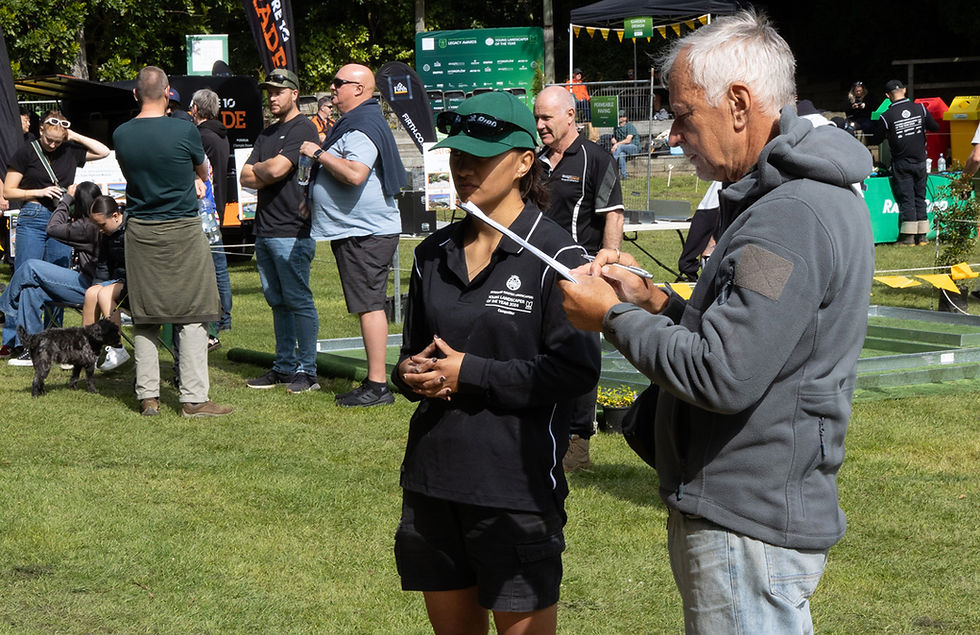A design for success
- NZ Landscaper
- Nov 1, 2024
- 4 min read
Updated: Nov 4, 2024

Jon Muller is a Registered Master Landscaper who specialises in design. In this article,
he shares what he’s learned about design work from his 26 years in business
While I’ve frequently designed hardscapes along with softscapes, I’ve always deferred to professionals who specialise in areas such as retaining walls during the design process, which is especially important for jobs on Wellington’s hilly areas.
In general, asking your client questions is important to ensure you’re all on the same page. So, here are three things that need to be asked when designing a landscape that includes both hard and soft elements:
1. Function: will it work?
2. Form: how will it look?
3. Budget: how much is it likely to cost and does
that tie in with the client’s budget?
When it comes to planting plans, a good knowledge of the following is needed:
1. Client preferences.
2. Local climate on site. Keep in mind that wind, sun and temperature can vary within a site!
3. Local soils on site. For example, lots of organic matter may have already been added, or the soil could be made up of cut away rock and very poor.
4. Plant availability from local nurseries, as it’s good practice to source plants from your local area.
The planting plan itself needs:
1. A scaled plan of the garden areas.
2. The position and number of plants shown on the plan.
3. A plant schedule with botanical name, common name, number of plants, and grade or pot size.
4. Photos of plants in order of the schedule to help the client visualise them.
5. General garden specifications, for example, soil amendments and staking.
Ensure accurate quoting
One of my most important rules is that I only quote from plans I’ve done myself. That’s because I know I’ll have asked the right questions and considered the site, and therefore the chances of plant failure are much lower.
I was recently asked to quote from planting plans drawn up by others by another firm. I said my preference was to start from scratch myself, meet the client, visit the site and do the plan from there.
Don't be afraid to walk away
It’s important to walk away from jobs if you have concerns. For example, I declined to plant from a plan that didn’t list quantities of plants and, furthermore, their placement wasn’t clear.
It also looked like a cut and paste design done by someone who wasn’t a landscaper. I’ve also declined work despite the plan being professional and including an interesting selection of plants that the client obviously liked. I turned it down as I hadn’t met the client, hadn’t visited the site, and there were too many players in the game, so the likelihood of something going wrong was high. It’s always best to have a simple relationship between the client, the designer/project manager and the contractor. As they say, too many cooks can spoil the broth. The other thing you need to consider if quoting from a planting plan is who does
the maintenance. Your maintenance notes need to be clear, otherwise, if plants die because a client wasn’t able to carry out maintenance properly, it could come back to bite you.
I always provide maintenance notes for clients. A garden you have designed and ensured is maintained is a great selling point!
As professionals, we need to ensure we get the best result, as a happy client will refer us to other clients or offer more work down the line. An unhappy client, on the other hand, could tarnish your reputation, even if the error wasn't you fault.
For example, I heard recently that a landscape architect from outside Wellington had designed a planting plan for a large Wellington property overlooking the ocean subject to extreme winds and salt loading. All the plants died, as they weren't suited to the environment. Is the landscape architect responsible for the failure or the person planting the plants?
My view is stick to your knitting. That means do what you’re good at and enjoy. It’s also important to stick to your rules. If you come into contact with someone who doesn’t want to abide by your rules, or you must break your own to do the work, then it’s best to walk away.
When work is slow, it’s easy to take on jobs you don’t feel good about – but those jobs are more likely to create frustration. It’s better to create a space to allow yourself to focus on good clients rather than run around putting out fires.
As they say: you’re only as good as your last job, so
why not make it in your favour? Happy planting!

Jon Muller has owned Wellington Gardens Ltd for 24 years. He practices landscape design and construction, with an emphasis on planting design.
He has taught at polytechnics and university, mostly in soft landscape subjects. He has written six gardening books, including Wellington Gardens, and enjoys helping clients find landscape solutions. He also helps students and workers studying for their landscape qualifications.
